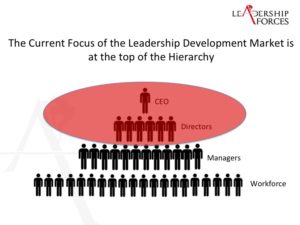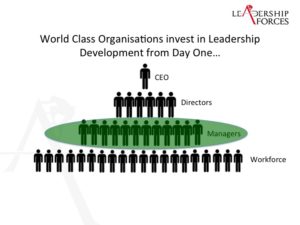I have been running a business specialising in leadership development for almost a year. Whilst I don’t consider myself a market expert, I thought it might be helpful to share a couple of observations that might be useful to people looking to enter the market or buy leadership development training.
The one theme that I have noticed is that there is a lot more supply than there is demand. I think that the reason for this situation is that the vast majority of leadership coaching organisations are focussed at the top of the organisational pyramid.
And when you think about it – that makes sense. If you’re paying the CEO of a company £300k per year, it is justifiable to spend a few thousand pounds on leadership coaching in order to improve their performance.
High salaries justify high fees – and I completely understand that.
But, if you’ve got to a senior leadership position in a large organisation – I would hope that you at least have a baseline level of competence. I would hope that you know how to build relationships, set a ‘vision’ and create systems to manage performance.
I know that this is a broad generalisation – but bear with me.
What I am saying is that the majority of CEO/Director level leaders have a baseline level of competence built-up throughout their career. They must have – otherwise, how did they get to this level?
Therefore – I would challenge how much of an improvement a coach can really offer to someone at this level as opposed to a first-time leader?
Think about it. More often than not, your first-line leaders get promoted because they are good at their job. But being good at your job is only one element in the equation. Leaders have to be able to get other people to perform – and most of the time, they learn this through trial and error.
Leading a Troop Attack
When I was being taught how to lead a Troop attack, the best piece of advice I was given was ‘put your rifle away’. The reason for this is if you’re concentrating on shooting, you are not concentrating on leading.
The impact you can have with one rifle is minimal but the impact you can have by coordinating three sections of Royal Marines, and calling in indirect fire and/or air support is going to make a significant difference.
Your job as a leader is to conduct the orchestra – not play an instrument


Let me go back to my comment on the leadership development market. It is focussed at the top of the pyramid – but let’s look at organisations that understand leadership. Let’s look at organisations that deliver high performance consistently in challenging environments.
Naturally – I am going to call on my experience in the military. Royal Marines Officer training is 15 months long and our Army counterparts spend about a year at Sandhurst before going through further role-specific training.
The military invest their time in training people to do the job properly from the outset.
No one joins the RAF knowing how to fly a plane.
They are taught how to fly ‘the RAF way’ in line with their standards and expectations.
In the civilian world, Toyota have what they refer to as ‘dojos’. These are simply classrooms where they train people to go on the assembly line. Everyone who joins the organisation gets taught in a dojo before they go and build Toyota products.
Why? Because why would you send someone to do a job without training them how to do it properly?!
The point I am making is that Toyota and the Military invest in training people up front. They get it right from the start. There is no fear of the ‘what happens if we train them and they leave?’ World Class organisations believe that it is a bigger risk not to train people. It is a bigger risk to ask their people to do something without teaching them how to do it properly.
Why – because it’s your customers that pay for it.
It’s customers who get frustrated when cars are poorly made or a service has been poorly delivered.
The performance of your organisation is entirely dependent upon its people – and the performance of the people are dependent on the leadership capability of the front-line managers.
So why doesn’t the leadership development market service this need?
Very simply – lower salaries make it harder to justify high fees.
This is a problem that has been irritating me since I launched my own business.
Everyone in the market is chasing the leaders at the top – but that’s not where the primary need lies. This thought stayed with me, percolating in the background of my mind until I met John Eades of Learnloft who said that he wanted to have an impact on the same problem. He wanted to help the millennial generation get access to leadership development.
We started to have a conversation about how we might be able to work together and produce a product that was designed for first-line leaders. Something that leveraged technology to give people the basics of what they needed to do in order to drive high performance.
Earlier this year, I flew to Charlotte, NC to work with John and his team to build the ‘High Performance Leadership Programme’. This is an online course designed at giving first-time leaders an understanding of what they need to do to drive performance. It is designed to set them up for success from day one.
I wanted to sift through all noise around leadership and give people what they needed to know. It is a combination of the lessons I learnt as a Royal Marines Officer and the approach I have used since then. It is a practical course designed to give leaders the tools that they need to successfully drive performance.
So how are you investing in your first-line leaders?
‘High Performance Leadership Programme’
Save
Save
Save
Save
Save




.JPG&w=600&c=0)
